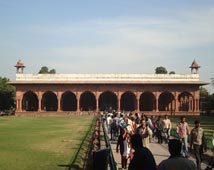
The Red Fort, Shah Jahan's elegant citadel in red sandstone, was built on the western bank of the river Yamuna. Shahjahan, started the construction of this massive fort in 1638, when he shifted the capital from Agra to Delhi. The fort was completed along with the huge city of Shajahanabad after nine years on 16th April 1648. This sandstone fort possess grand audience halls, marble palaces, once embedded with precious stones, a market place where the royalty used to shop, a mosque, gardens with marbled fountains, plazas, baths etc.
There are 15 distinct structures within the fort with the first being the Lahore Gate and the last one the Moti Masjid.
The Lahore Gate: The Lahore Gate of the palace is veiled by the Babar added by Aurangzeb, a Mughal emperor. The gate is from where the Prime Minister addresses the nation and unfurls the National Flag on August 15, Independence Day.
Chatta Chowk: The entrance of the Gate leads through a long covered bazaar called the Chatta Chowk. From Chatta Chowk follows the Naqqar Khana(Drum Room) also called Naubat Khana or the Welcome Room, which earlier formed part of a square enclosure with apartments for the umrah (Nobles) on duty. It was at this point that everyone other than the Emperor had to dismount from their elephants and walk towards the magnificent Diwan-e-Am(hall of public audience) where the Emperor used to listen to the grievances of the common man.
Naqqar Khana : The Naqqar Khana is 49 feet high with an open arched hall at the top which served as a music gallery from where the strains of music filtered down to welcome the Emperor or to bid him a safe journey. The War Memorial Museum is housed on the first floor. The Diwan-e-Am is built of red sandstone and is set atop an impressive plinth. The southwest and northwest corners of the pavilion are articulated by small chhattris.

Diwan-i-Am: The Fort also houses the Diwan-i-Am or "the Hall of Public Audiences", where the Emperor would sit and hear complaints of the common folk. His alcove in the wall was marble-paneled, and was set with precious stones, many of which were looted, after the Mutiny of 1857.
Diwan-i-Khas: The Diwan-i-Khas is "the Hall of Private Audiences", where the Emperor held private meetings. This hall is made of marble, and its center-piece used to be the "Peacock Throne", which was carried away to Iran by Nadir Shah in 1739. Today, the Diwan-i-Khas is only a pale shadow of its original glory, yet the famous Persian couplet inscribed on its wall reminds us of its former magnificence: "If on earth be an eden on bliss, it is this, it is this, none but this."
Sound And Light Show: A sound and light show is held every evening giving an idea of the Mughal history, both in Hindi and English. The timings for summer Hindi 7 p.m. to 8 p.m. and English 8 p.m. to 9 p.m., and for the winter they are in Hindi 6 p.m. to 7 p.m. and English 7 p.m. to 8 p.m.